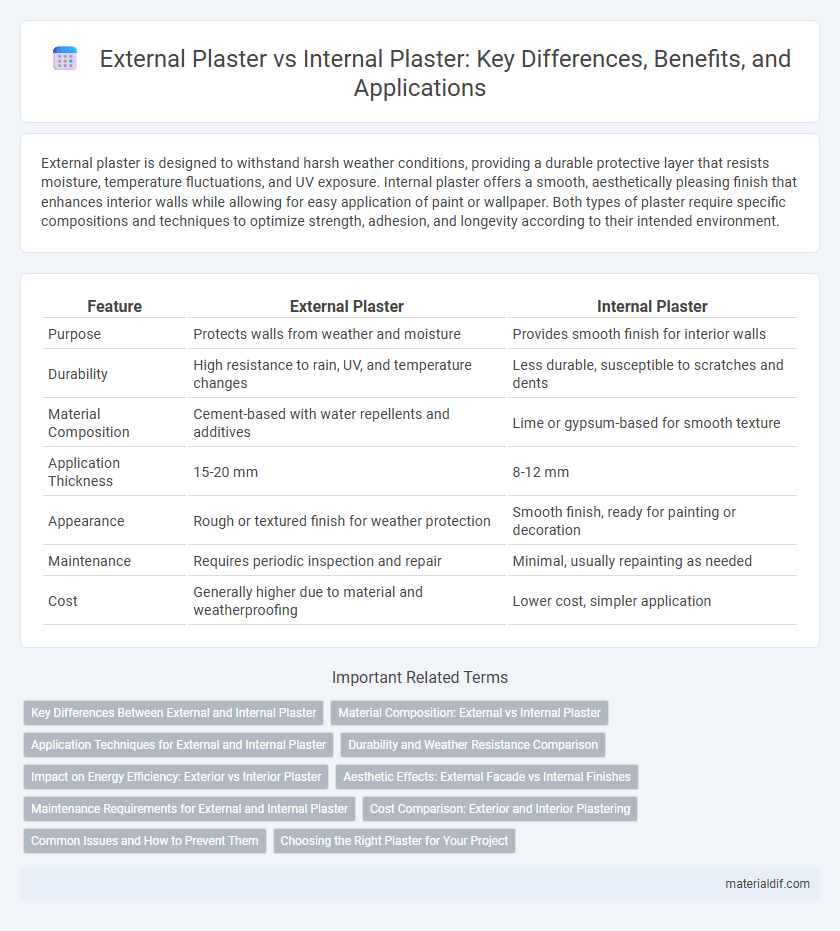External plaster is designed to withstand harsh weather conditions, providing a durable protective layer that resists moisture, temperature fluctuations, and UV exposure. Internal plaster offers a smooth, aesthetically pleasing finish that enhances interior walls while allowing for easy application of paint or wallpaper. Both types of plaster require specific compositions and techniques to optimize strength, adhesion, and longevity according to their intended environment.
Table of Comparison
| Feature | External Plaster | Internal Plaster |
|---|---|---|
| Purpose | Protects walls from weather and moisture | Provides smooth finish for interior walls |
| Durability | High resistance to rain, UV, and temperature changes | Less durable, susceptible to scratches and dents |
| Material Composition | Cement-based with water repellents and additives | Lime or gypsum-based for smooth texture |
| Application Thickness | 15-20 mm | 8-12 mm |
| Appearance | Rough or textured finish for weather protection | Smooth finish, ready for painting or decoration |
| Maintenance | Requires periodic inspection and repair | Minimal, usually repainting as needed |
| Cost | Generally higher due to material and weatherproofing | Lower cost, simpler application |
Key Differences Between External and Internal Plaster
External plaster is formulated to withstand harsh weather conditions, featuring moisture resistance and durability against temperature fluctuations, while internal plaster prioritizes smoothness and aesthetic finish suitable for interior walls. Materials for external plaster often include cement-based mixes with waterproof additives, whereas internal plaster commonly uses gypsum or lime-based mixtures for better workability and breathability. The application techniques also differ, with external plaster requiring thicker layers and more robust reinforcement to prevent cracking and water ingress.
Material Composition: External vs Internal Plaster
External plaster typically consists of cement, sand, and lime to provide weather resistance and durability against environmental elements, while internal plaster often contains gypsum, lime, and fine sand for smooth finishes and ease of application. The higher cement content in external plaster enhances its waterproofing and bonding properties, making it suitable for outdoor surfaces exposed to rain and temperature fluctuations. Internal plaster prioritizes breathability and surface smoothness, facilitating better adhesion of paint and decorative finishes within interior spaces.
Application Techniques for External and Internal Plaster
External plaster requires robust application techniques including the use of water-resistant bonding agents and multiple coats to withstand weather elements, often applied with a trowel in smooth, consistent layers for durability. Internal plaster demands precise mixing to ensure a smooth finish, typically involving a base scratch coat followed by a finishing lime or gypsum plaster to provide a fine, even surface ideal for paint or wallpaper. Proper curing times and temperature control are critical for both external and internal applications to prevent cracking and ensure long-lasting adhesion.
Durability and Weather Resistance Comparison
External plaster is formulated with additives like cement and polymers to enhance durability and resist weather elements such as rain, UV rays, and temperature fluctuations. Internal plaster typically uses lime or gypsum-based mixes designed for smooth finishes and does not withstand moisture or harsh weather conditions. The reinforced composition of external plaster ensures longer-lasting protection and structural integrity compared to the more delicate, aesthetic-focused internal plaster.
Impact on Energy Efficiency: Exterior vs Interior Plaster
External plaster significantly enhances energy efficiency by providing an insulating barrier that reduces thermal bridging and minimizes heat loss through building envelopes. Internal plaster contributes to thermal mass, stabilizing indoor temperatures by absorbing and slowly releasing heat, which supports passive heating and cooling strategies. Combining both exterior and interior plaster optimizes overall building energy performance by balancing insulation with thermal inertia.
Aesthetic Effects: External Facade vs Internal Finishes
External plaster enhances the building's facade by providing weather-resistant coatings that maintain color consistency and texture durability under harsh environmental conditions. Internal plaster offers smooth, refined surfaces ideal for decorative finishes, allowing for intricate designs, paint applications, and improved lighting reflection within interiors. The aesthetic effects differ significantly, with external plaster prioritizing longevity and protection, while internal plaster emphasizes visual appeal and tactile quality.
Maintenance Requirements for External and Internal Plaster
External plaster requires regular maintenance to address weather-induced wear, including cracks, moisture damage, and algae growth, necessitating periodic repainting and patching to preserve structural integrity and appearance. Internal plaster tends to demand less frequent upkeep but benefits from routine inspection to repair minor cracks, prevent mold due to humidity, and maintain smooth surfaces for aesthetic appeal. Choice of plaster materials and protective coatings significantly influences maintenance frequency and long-term durability for both external and internal applications.
Cost Comparison: Exterior and Interior Plastering
Exterior plaster typically incurs higher costs due to the need for weather-resistant materials and more durable finishes, which increase both material and labor expenses. Interior plastering is generally more affordable, benefiting from less stringent material requirements and simpler application techniques. Cost differences also stem from the complexity of surface preparation and finishing standards required for external environments compared to interiors.
Common Issues and How to Prevent Them
External plaster often faces challenges like cracking, dampness, and blistering due to exposure to weather and temperature fluctuations, which can be prevented by using high-quality weather-resistant materials and proper surface preparation. Internal plaster commonly suffers from shrinkage cracks, efflorescence, and fungus growth caused by moisture and inadequate ventilation; these issues can be minimized through controlled mixing ratios, timely curing, and ensuring proper room ventilation. Regular maintenance and adherence to correct application techniques are crucial for both external and internal plaster to enhance durability and finish quality.
Choosing the Right Plaster for Your Project
Selecting the appropriate plaster depends on the project's location and environmental conditions; external plaster requires water-resistant, durable materials like cement or lime-based plaster to withstand weather elements. Internal plaster typically uses gypsum or lime plaster, offering a smooth finish ideal for interior walls and ceilings with controlled humidity. Properly matching plaster type ensures longevity, aesthetic appeal, and structural integrity in both external and internal applications.
External Plaster vs Internal Plaster Infographic

 materialdif.com
materialdif.com